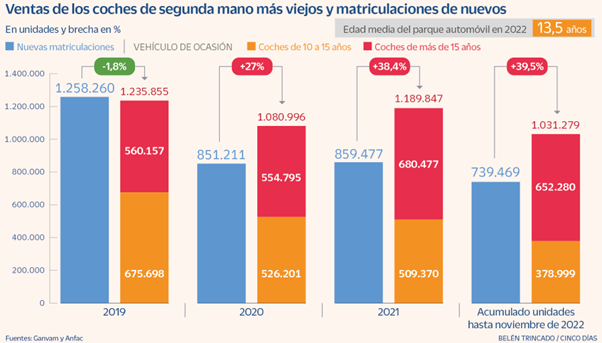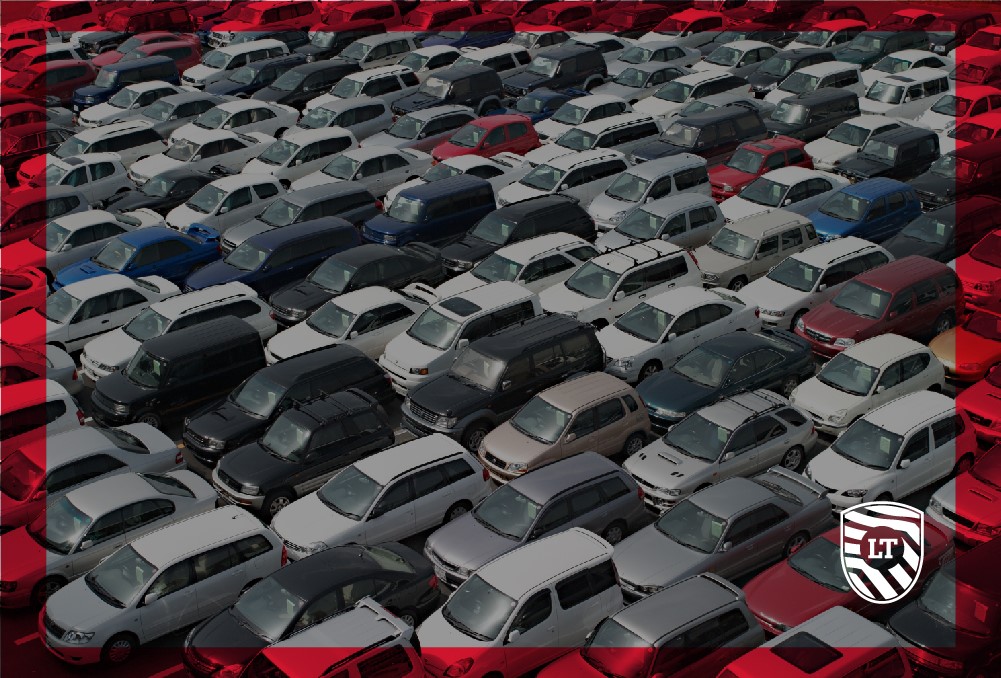The Spanish car fleet continues to age
The automotive market in Spain is immersed in a major crisis since 2020 in terms of production, sales and registrations of new vehicles. According to Anfac data, in 2022 deliveries continue 4.4% below the previous year, with just 739,469 cars sold. If the comparison is made with 2019, the market is 36% below the pre-pandemic.
And something similar happens at the level of vehicle manufacturing in Spain, where, despite the increase in production in 2022, we are still 23% below the production rate prior to the pandemic, with about 600,000 fewer units manufactured, “explained the employers of cars, Anfac.
A sales and manufacturing crisis initiated because of the economic crisis, generated by the coronavirus pandemic, to which is added the lack of microchips globally, the increase in fuel prices, the increase in inflation and a change in the mobility model.

Consumer habits have changed, and more and more Spaniards do not want to make the outlay of money involved in acquiring a new vehicle (something increasingly expensive due to the increase in taxes) In addition, among urban young people the car is no longer perceived as something essential and they bet on other more practical vehicles for large cities (motorcycles, scooters, ebikes…) and caravans, which have become fashionable again as an ideal means of transport for trips without having to spend on accommodation.
In Spain, 40% more cars over ten years old are sold than new
Buying a new vehicle is no longer a priority for many Spaniards and registrations are falling year after year. More and more users rely on social networks, exchange platforms and websites dedicated to the sale of second-hand or websites for buying and selling used cars to buy cheap cars, motorcycles and caravans.
The data indicate that in Spain, for every new car sold, 2.3 second-hand cars are sold. Since 2019, the sale of second-hand and second-hand vehicles has increased by almost 25%.
And everything indicates that during 2022 and 2023, this market will maintain its growth. According to data from GANVAM (National Association of Motor Vehicle Sellers, Repair and Spare Parts) the Spanish market has the capacity to sell more than two million used cars per year.
Although the second-hand market as a whole has also fallen by 5.2% throughout 2022, sales of older cars have increased in absolute terms.
The Spanish car fleet has an average of 13.5 years
The most worrying fact of this growing second-hand car market is that the Spanish car fleet does not stop aging and in 2021, according to Anfac data, the average age of our car fleet was 13.5 years, a figure that has not stopped increasing since 2007 and that is two years higher than the European average.
And the trend is not very positive: in 2022, 652,280 vehicles with more than 15 years old were sold.
The result is an increasingly unhealthy second-hand market that hinders the much-needed renewal of the car fleet.
This difference in favor of older vehicles did not exist before the pandemic. In 2019, registrations narrowly exceeded sales of cars over 10 years old (by just 1.8%). However, a year later, transactions of older vehicles exceeded sales of new vehicles by 27%, a percentage that has been expanding to the current 39.5%.
Cars over ten years old account for 60.9% of second-hand vehicle sales in Spain.
Some of the causes of this boom of the old car
The lowest supply of rental cars
Since the beginning of the shortage of semiconductors, manufacturers chose to focus their sales on the two channels that bring them the most benefits, the channel of companies and that of individuals, to the detriment of the rent a car sector or renters that is traditionally the one that offers newer vehicles to the second-hand market, so these companies have to keep the vehicles they already had for longer.
The car rental or rent a car channel closed the year 2022 with only 114,481 units registered between cars and industrial vehicles, which represents a significant drop of 35.58% compared to the previous year, according to data from the MSI consultancy for Feneval, the National Business Federation of Car Rental.
According to the president of Feneval, Juan Luis Barahona, they do not expect the situation to improve much this year and has again requested car brands that, “given the forecast of record numbers of tourists for this 2023 of the Ministry of Industry, Trade and Tourism, maintain 20% of the total sales of New Vehicles to rent a car to be able to continue meeting the demand. “
Rising inflation and economic instability
To this is added the current macroeconomic context, with high inflation that has been transferred to car prices. The latter is especially evident among second-hand cars, which until September (latest data available) have increased their price by 19%, to 17,950 euros on average, according to Ganvam data.
“The economic uncertainty is making the Spanish market bet on the used vehicle, which raises prices due to the greater demand,” says Gerardo Cabañas, general director of Coches.com.
Data for optimism
Despite this problem, car production in Spain continues to increase at a double-digit rate thanks to the improvement in the supply of chips and components. In November 2022, national factories assembled more than 226,000 vehicles, representing an increase of 16.9% compared to the same month last year, according to data provided by Anfac,
Until November 2022, 4.2% more cars had been manufactured in Spain than in the same period of 2021, with a total of 2.03 million vehicles, which would allow it to close the year with some 2.2 million vehicles manufactured.
Even so, domestic manufacturing is still 23% below the pre-pandemic production rate, and with about 600,000 fewer units manufactured.
By type of vehicle, passenger cars grew the most in November, with 18.4% more (184,306 units), while industrial and commercial vehicles increased by 11%, to 41,858 cars. However, so far this year the latter continue in negative numbers, with a decrease of 2.8% compared to the first eleven months of 2021.
Improves profitability in the industry
Although sales fall, the profits of some manufacturers, which are adapting to an environment of lower sales, grow. For example, in the Volkswagen group in the first nine months of the year it sold 3.4% fewer units worldwide (6,243,000 vehicles) compared to the same period of 2021, increased its revenues by 8.8% (203,000 million euros) and its profits after taxes climbed by 12.4%, to 12,771 million.
Brands prioritize sales of models that report the most margins, that is, premiums.
Stakeholders call for solutions to strengthen the automotive industry
To alleviate this aging of the fleet, the sector calls for measures that encourage the purchase of a new car and that this is not necessarily electric, since it is a type of vehicle that is not yet available to the entire population and still generates uncertainty in drivers regarding the autonomy and availability of charging points. “
The last Renové plan lasted until 2020 and was not extended. Today there are Renové plans in certain autonomies, such as in Galicia. The Moves 3 Plan is very energy-efficient oriented and prioritizes electric vehicles, which is positive for urban areas, but not so much for rural areas where charging infrastructure is poor.
From Anfac, the National Association of Car and Truck Manufacturers, warn of the serious consequences of this situation. The increase in registration tax that came into force in January this year does not benefit the sector either. The Director of Communication of Anfac, Noemi Navas, has noted that the automotive industry is weakening and runs the risk of losing the relevant position it holds in terms of GDP and quality employment in our country.
For its part, the National Association of Vehicle Dealers defends the implementation of a specific recovery plan for the automotive sector. Appropriate measures to revive and boost the automotive sector are being considered.
One of the main measures that this plan would include is the freezing of registration tax, in order to motivate buyers and that the sale of vehicles rises. On the other hand, a reduction in the hydrocarbons tax or a reduction of VAT to 10% for electric cars is also being studied.
The oasis of electric cars
Arguably, the only ones that haven’t been hit so hard by this whole situation are electric vehicles. Buyers are increasingly attracted to this option and its sale continues to rise despite the crisis situation, high prices and the lack of cargo structure.
Electric cars continue to gain strength in our country since 2020, despite the fall in sales of other vehicles. It currently has a market share of 3%, which compared to the sales figures of thermal vehicles is not much, especially if we compare it with other European countries.

According to data from the consultancy Jato, the electric car captured 15% of the market share in northern Europe in the third quarter of this year, compared to 3.8% in the south, that is, almost four times more.
The country that has long led the sale of electric vehicles for several years is Norway, where almost three out of four registrations are electric.
One of the main problems to explain the low sales of electric cars in Spain is the scarce public charging infrastructure that the country has. Not only in quantity, but also in quality. To which is added the low amount of tax aid and our lower purchasing power.
In Spain only 2.48% of the 16,565 public charging points that Spain has allow charging the vehicle in less than half an hour, 81.4%, are points with a power of at most 22 kW, which have a charging time of a minimum of three hours.
In Portugal, the market share of electric and hybrid is around 20%. Why? Because one of the measures they have is that if you buy one of these vehicles, 21% VAT is deducted. Portugal has worse per capita income than Spain. In a country with more per capita income such as Germany, direct purchase aid amounts to 10,000 euros. The car costs 45,000 euros at the dealership, you pay 35,000 euros and you forget. Not here in Spain,” says Félix García, Anfac’s communications director.
By energy sources, pure electric cars accounted for 5.9% of the production share in November, while plug-in hybrids accounted for 7.4%. Both types of vehicles have increased their production by 66.9% and 64.7%, respectively.
In 2022, pure electric vehicles had 5.4% of manufacturing share, with 110,680 cars assembled in Spain, and plug-in hybrids 6.4%, with 130,780 units. Between them, they accumulate a production volume of more than 241,000 vehicles, 11.9% of all cars manufactured in our country.
Electrification must be accompanied by the renovation of the park. Our estimates are that to meet the decarbonization targets in 2030 we would have to reduce emissions by 3.6% each year. We are now at 1%. We are reducing the emissions of new registered cars, but as the fleet is aging, it has a negative effect on us. The renewal can occur with a Renove plan, but also with a fiscal change, “he proposed in an interview with Five Days José López-Tafall, general director of Anfac,
2035 may be the decisive year for the European automotive industry
Among all the uncertainty surrounding the future of the automobile in Europe, in November 2022 The European Union, in the framework of its struggle to reach climate neutrality in 2050, confirmed a preliminary agreement that leaves the days numbered the possibility of buying in the market first-hand a diesel car or van, gasoline or hybrid within the borders of the nations that compose it.
From 2035, only 100% electric cars and vans will be allowed to be sold. Not even hybrid vehicles will escape the veto.
In the hypothetical event that the ban came into force on that date, the Spanish automotive industry would lose more than 96% of its sales, and all this despite the increase they have registered and the efforts and investments of manufacturers to offer less polluting alternatives to consumers.
The picture is not very different in the rest of the CEE, according to the latest data available from the European Automobile Manufacturers’ Association (ACEA), corresponding to the end of 2020, passenger cars powered exclusively by electric battery, the only ones that will be legal to sell new ones when the time comes, represented on average in the EU 0.5% of the total passenger cars in circulation, without the percentage going beyond 2% in any country of the club.
The automotive industry in Spain
Spain is the 2nd European vehicle manufacturer and 9th in the world. In Spain there are 9 multinational brands established with 17 plants, which in 2021 assembled 2.1 million vehicles, including 16 electrified versions.
1,000 automotive suppliers belonging to 720 business groups are installed in the country, guaranteeing the service and supply of the Manufacturing Plants
The turnover of the automotive industry as a whole (manufacturers and components) represents 10% of Spanish GDP and is responsible for 18% of total Spanish exports. The trade surplus of the vehicle manufacturing sector reached 18.9 billion euros in 2021.
Spanish production plants are among the most efficient and automated in Europe with 1,000 industrial robots per 10,000 employees. This sector has one of the highest rates of investment in modernization, automation, and R + D + i among industrial sectors.
Despite all this potential, the Spanish automotive industry is experiencing moments of uncertainty in the domestic market with a continued decline in sales, despite the good performance of electrified vehicles, due to the economic situation, the lack of subsidies and a change in perception of the car as a status symbol.
Meanwhile, the second-hand market continues to grow at the level of companies and individuals, which is causing a worrying aging of the car fleet.
And all this, with the European threat of a total ban on selling any new vehicle that is not fully electric by 2035, which could mean losing 96% of vehicle sales.



